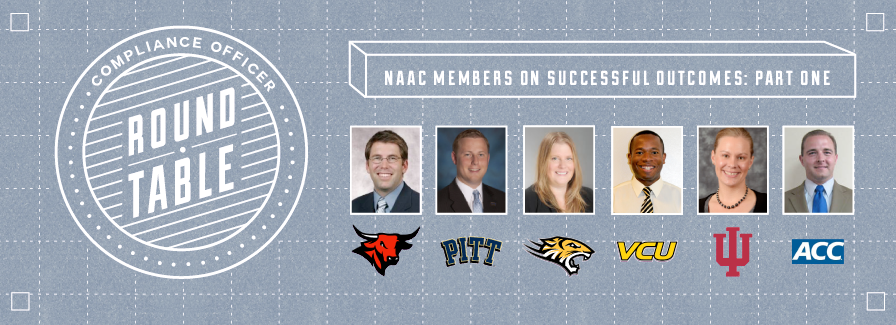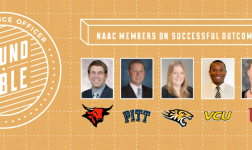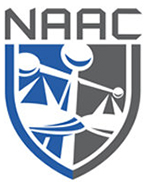
The pressures on college athletics programs for increased accountability, transparency, and fairness ensure that the compliance officer—liaising with many departments and communities on campus—is one of the most vital roles in an athletic department. NAAC—the National Association for Athletics Compliance—is the industry organization for compliance professionals and its mission is to “foster the highest possible professional and ethical standards…[and] improve the overall understanding and effectiveness of the athletics compliance profession, while upholding the ideals of higher education.”
Compliance officers nationwide are working diligently to implement new reforms and educate staff and student-athletes about the potential for violations and infractions. Ryan Matthews—Winthrop’s Managing Editor—sat down recently with six NAAC members: Josh White, (NAAC’s First Vice President) Sr. Associate Athletic Director at the University of Nebraska Omaha Athletics; Daniel Bartholomae, (NAAC’s Second Vice President) Associate Athletic Director For Compliance and Sports Services at the University of Pittsburgh; Tricia Turley Brandenburg, (NAAC’s Third Vice President) Deputy Director of Athletics for Internal Operations at Towson University; Ikechi Ukaegbu, Associate AD for Compliance at Virginia Commonwealth University; Kristine Fowler, Associate Athletic Director for Compliance at Indiana University; and Matt Burgemeister, Assistant Commissioner – Compliance & Governance at the Atlantic Coast Conference to discuss complex compliance scenarios, issues that aren’t discussed often enough, and new efficiencies that are changing the role of compliance for the better.
What are some success stories—examples of compliance getting an issue right or dealing with a difficult scenario effectively?
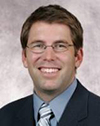 Josh White – University of Nebraska Omaha
Josh White – University of Nebraska Omaha 
Senior Associate Athletic Director – NAAC’s First Vice President
Success stories happen every day on campus. It may come from an interpretation that was difficult to find, or it may come from helping get an eligibility waiver approved. More important than the success stories is the role of the Compliance professional. Compliance professionals are some of the best problem solvers that I know. In fact, these individuals are constantly searching for the right answer to a question and/or dealing effectively with difficult situations. The role of the compliance professional has expanded on campus in my 15 years in the business. On campus today, Chancellors/Presidents and Athletic Director look to the compliance professional to walk them through the NCAA Governance process, be risk management advisors, policy makers, conflict resolution specialists, contract negotiators, mediators and strategic planners. In order to be good at these types of things, compliance professionals need to be trusted, have the ability to get an issue right, and deal with difficult scenarios effectively.
Another success story is the growth of NAAC (National Association for Athletics Compliance). Since 2009, NAAC has more than doubled its membership from 420 members to over 900 today. The growth of NAAC parallels the growth of the industry as a whole. Now more than ever people in the compliance profession are looked to as leaders on campus regarding many different areas and not just NCAA rules.
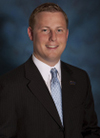 Dan Bartholomae – University of Pittsburgh
Dan Bartholomae – University of Pittsburgh 
Associate AD, Compliance & Sport Services – NAAC’s Second Vice President
To break this down campus by campus would be difficult! The truth is, there are exponentially more compliance “success” stories every day than the opposite. The role of the compliance professional has expanded to include so many different student services – Financial Aid, Academic Eligibility, Waivers, Life Skills, Administration of the Student Assistance Fund … the list goes on and on. Every day that we work directly with a student-athlete or coach and develop that relationship is a successful one. Certainly, there will be moments of conflict or disagreement … however, does that make our role any different than that of the Athletic Director, the Chief Business Officer, or any other executive? Similar to those individuals, it is the professional equity already built up that is going to dictate how those situations go.
I think some of the success stories you see now—that are specifically a product of how the industry has grown—are the amount of compliance professionals getting athletic director and interim athletic director jobs. That is good for our industry, but also good for college athletics when you consider the strong skill-set these compliance professionals have in areas related to student-athlete welfare. Fortunately, we are in an industry where you are now one of the key problem solvers on campus, and you are engaged with every aspect of the University community. Who else talks to the head basketball coach, the star athlete, the Provost, the Athletic Director and the University President on the same day? It is very rare but specific to the Senior Compliance Professional. When you consider that, it is no wonder we are increasingly looked at to fill that role.
Nationally, our other success is our efforts to organize. The networks of compliance professionals I see being established nationally – whether through NAAC, Mentor Programs, Conference Affiliations – are making our industry more accountable, more professional and smarter. We have an organized voice and plenty of practical legislative and governance related experiences upon which to comment on.
 Tricia Turley Brandenburg – Towson University
Tricia Turley Brandenburg – Towson University
Deputy Director of Athletics for Internal Operations – NAAC’s Third Vice President
The current landscape of college athletics is a challenge in and of itself. I think if you took a look at all that the National Association for Athletics Compliance (NAAC) has accomplished in the last few years, it’s really remarkable. NAAC has gotten compliance professionals engaged and invested in their profession to great results. Reasonable Standards have been and continue to be created on various compliance issues, NAAC has been involved with the reform process especially in Enforcement, and NAAC is in the process of launching an education certification program. All of these programs and involvement demonstrate the value of the compliance professional within the overall landscape of college athletics and also show that the compliance professional is willing to be part of the solution to the issues we’re currently facing.
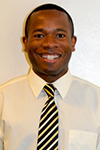 Ike Ukaegbu – Virginia Commonwealth University
Ike Ukaegbu – Virginia Commonwealth University
Associate AD for Compliance
Throughout my seven-year career as an Athletics Compliance Administrator, there have been a few instances (both expected and unexpected) where incoming student-athletes were deemed non-qualifiers in regards to NCAA Initial Eligibility. Per NCAA rule, a non-qualifier may not receive an athletic scholarship and may not practice/compete during the first year of enrollment. In the majority of the these situations, my compliance staff submitted initial eligibility waivers on behalf of the student-athletes to the NCAA Office. Most of the waivers submitted were either partially approved to allow the student-athlete to receive an athletic scholarship and become eligible for just practice or fully approved to allow the student-athlete to receive an athletic scholarship and become eligible for both practice and competition. It is very rewarding when you are able to be a part of turning an unfortunate situation into a fortunate one.
 Kristine Fowler – Indiana University
Kristine Fowler – Indiana University
Associate Athletics Director for Compliance
This is a difficult question to answer – compliance offices are doing their best work when they literally go “unnoticed” which is similar to a game where the referees go unnoticed because they are doing such a great job getting the calls right and dealing with the play of the game effectively.
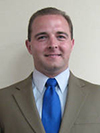 Matt Burgemeister – The ACC
Matt Burgemeister – The ACC
Compliance & Governance
The great news is that successes are much more common than regularly reported. I primarily think about this through the positive impact compliance can have on the student-athlete experience – knowledge of funds, programs and resources that are available to support student success; advising student-athletes to help them achieve and maintain eligibility (both academic and otherwise); and helping a student-athlete to participate in athletics opportunities as allowed by NCAA policies. I also think you can look at the compliance profession itself as a success story.
The growth and development of compliance over the past 15 years or so is a reflection of the quality people who work in this area, their relationships and influence throughout the athletics department, and their ability to constructively tackle challenging issues. This is true at the campus and conference level as well as within the NCAA governance structure. In addition, administrators with a compliance background are starting to be considered for athletics director and other senior level positions, which speaks to the fact that compliance must have productive relationships with every team and administrative unit with the athletics department.
What’s the prevailing dialogue about compliance and what should the general public and athletics administrators know that doesn’t get enough attention?
 Josh White – University of Nebraska Omaha
Josh White – University of Nebraska Omaha 
Senior Associate Athletic Director – NAAC’s First Vice President
The prevailing dialogue on our campus is very positive about governance and compliance. Our athletics director is a big proponent of the compliance office and includes our Assistant AD for Compliance on major issues, whether or not it deals with an NCAA issue.
One area where I do believe there may be a bit of a disconnect exists because Compliance Professionals are often the central “hub” communication on campus. Specifically, compliance professionals will communicate daily with student-athletes, coaches, athletics staff, campus staff, conference staff and NCAA staff. Taking it further, they will also communicate with donors and fans. Because of this they will develop relationships with a wide array of people and often know what is going on in every department inside athletics and campus as well.
 Dan Bartholomae – University of Pittsburgh
Dan Bartholomae – University of Pittsburgh 
Associate AD, Compliance & Sport Services – NAAC’s Second Vice President
I am not sure what the “prevailing dialogue” is. I see a lot of negativity about the NCAA and rules in the media, and I think naturally the public assumes that is a reflection on us. But consider that enforcement matters represent about 2% of what I do on a day-to-day basis. It is an important and necessary part of the job, but my conversations with peers are rarely investigative or confrontational in nature. It would be great to see a story on the Student Assistance Fund and some of the strategies we (as compliance professionals) have employed to use that money on career development, misfortunate expenses, life skills, etc., to give directly to our student-athletes, as opposed to a story on the membership’s inability to agree on an expense allowance and their enforcement of extra benefit legislation (that we as individuals might oppose) that then somehow is reflected upon us as individuals. There is a lot of misconception about what we do, and where we fit into the process.
I also believe nationally we may not get enough attention directed towards how keyed in we really are on legislative and governance issues. We are the ones on campus who touch these issues every day. When legislation passes in a hasty manner, we are usually the ones who already knew what the negative externalities were going to be. This is another area NAAC has focused on, and we are really working on some avenues to make those organizational efforts of use nationally, such as our Reasonable Standards, and our Thought Leaders and Legislation/Governance committees.
One example where I believe the compliance profession should be engaged, but is not, is in the current governance review. The national office is engaged in a significant governance review, and have identified several professions and organized groups within the membership from which to obtain feedback, but none of those groups include an organized segment of the compliance profession. It seems that if we are going to have a national conversation on issues, we should be a part of it. That is not to take away from the other groups already involved … they are there for a reason and their opinion is as valid as anyone else. I just think we are missing one key component of the membership. Certainly I am not assigning blame … this is a huge initiative with a lot of moving parts, and perhaps NAAC and our profession needs to stand up and force some of these decision makers to take notice on what we bring to the table.
 Tricia Turley Brandenburg – Towson University
Tricia Turley Brandenburg – Towson University
Deputy Director of Athletics for Internal Operations – NAAC’s Third Vice President
Compliance professionals are doing what they can to have an impact on the legislative and enforcement processes on a national level through NAAC, but there is not a designated seat at the table in these discussion for compliance professionals. NCAA rules are created by the membership, but the designated seats at the table are for Presidents, Athletic Directors, Senior Woman Administrators, Faculty Athletic Representatives, Head Coaches and Student Athlete Advisory Board members. Therefore, unless the compliance administrator is also the Senior Woman Administrator or is otherwise nominated by their conference and appointed by the Administrative Cabinet, there may not be someone who is working in compliance day to day on any of the cabinets, committees or task forces that are shaping NCAA rules and reform.
 Ike Ukaegbu – Virginia Commonwealth University
Ike Ukaegbu – Virginia Commonwealth University
Associate AD for Compliance
I would say that the prevailing dialogue about compliance surrounds the new culture of Head Coach Control. Recently, the NCAA indicated that collegiate head coaches will be held accountable for the compliance related actions of assistant coaches and/or other subordinates associated with the program if the NCAA can establish that the head coach did not: (1) take appropriate measures in promoting an atmosphere of compliance, and did not; (2) continue to monitor the measures taken to ensure compliance within the program. This rule change is a means of punishing head coaches for their failure to act rather than punishing them for actions they have taken. In other words, a head coach can now be punished for failing to take measures that result in the promotion of an atmosphere of compliance. Head Coaches could potentially be suspended for one contest, half of a season, or an entire season depending on the mitigating/aggravating circumstances surrounding their violations.
 Kristine Fowler – Indiana University
Kristine Fowler – Indiana University
Associate Athletics Director for Compliance
Compliance is often seen as the cops of college athletics. In my opinion this is certainly not the case as most compliance administrators and offices really focus on being proactive, helping their coaches gain the competitive edge while playing within the rules, and serving as a resource for prospective student-athletes, parents, student-athletes, and coaches when they have questions.
 Matt Burgemeister – The ACC
Matt Burgemeister – The ACC
Compliance & Governance
Unfortunately, it does seem like violations and potential violations get most of the attention. In terms of national dialogue, there are several topics receiving significant public attention that are related to compliance or where compliance professionals can provide meaningful insights – the NCAA governance review, the collegiate model of athletics, and benefits for student-athletes to name a few. I think many compliance folks are engaged in these conversations on their campus and have significant insights based on ground-level experience with these issues. Some compliance professionals have been involved in these national conversations as members of the Rules Working Group and other bodies, and NAAC also has committees organizing and communicating the “compliance perspective.” As noted previously, it would also be great if attention could be drawn to the great work that compliance professionals do to support student-athletes.

